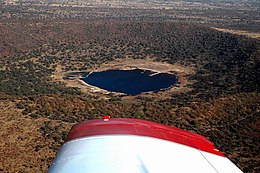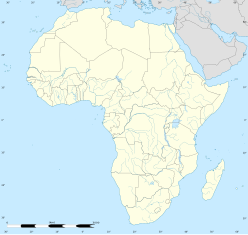Tswaing crater
| Tswaing crater | |
|---|---|
 Tswaing crater as seen from above | |
| Impact crater/structure | |
| Confidence | Confirmed |
| Diameter | 1.13 km (0.70 mi) |
| Depth | 100 m (330 ft) |
| Impactor diameter | 30 to 50 m (98 to 164 ft) |
| Age | 220 ± 52 Ka |
| Location | |
| Coordinates | 25°24′32″S 28°4′58″E / 25.40889°S 28.08278°E |
| Country | South Africa |

Tswaing (
Etymology
The name Tswaing means "place of salt" in Tswana and the crater was also formerly known in English as the Pretoria Saltpan crater and in Afrikaans as Soutpankrater, due to the highly saline lake on the crater floor.[1]
Palaeoclimatology
Lipid biomarkers and carbon and hydrogen isotopic ratios from the lake indicate the existence of regional humid climatic periods between 84,000 and 80,000 years BP and between 50,000 and 39,000 BP. In contrast, intervals of high aridity occurred around 76,000 BP, from 73,000 to 69,000 BP, from 55,000 to 51,000 BP, and from 31,400 to 12,600 BP. Since 84,000 BP, the vegetation of the region around the lake has been dominated by savanna-type plants.[5]
History
Stone tools from the
A scientific dispute was ongoing regarding the origin of the crater between supporters of volcanic origin (Wagner, 1922) and those who believed it is an impact crater (Rohleder, 1933) until 1990, when examination of the core from a borehole proved that it is an impact crater.[7]
Museum
"Place of Salt" | |
 Crater seen from its eastern rim | |
 | |
| Location | Pretoria, Gauteng, |
|---|---|
| Coordinates | 25°24′31″S 28°04′57″E / 25.408486°S 28.082529°E |
| Type | Natural history |
| Public transit access | Onderstepoort Road ( M35), Soshanguve, Pretoria |
| Website | ditsong |
| Ditsong Museums of South Africa network | |
The impact crater is accompanied by the Ditsong Tswaing Crater Museum.[8]
Status of protection
Tswaing is currently on the tentative list for consideration as a World Heritage Site.[9]
See also
- Impact event
- List of impact craters in Africa
References
- ^ . Retrieved 4 April 2023.
- ^ Reimold, W.U. (1998-04-27). "Meteorites and Meteorite Craters". South African Astronomical Observatory (SAAO). Retrieved 2008-08-23.
- ^ a b "Tswaing and its environmental effects". Lunar and Planetary Institute. Retrieved 2008-08-23.
- ^ "Tswaing". Earth Impact Database. Planetary and Space Science Centre University of New Brunswick Fredericton. Retrieved 2009-08-16.
- . Retrieved 7 January 2023.
- ^ Tswaing information leaflet
- ^ "Tswaing crater". Wondermondo. 11 February 2013.
- ^ "Tswaing Meteorite Crater". Ditsong Museums of South Africa. Retrieved 2023-06-28.
- ^ "Tentative Lists, Tswaing Meteorite Crater". UNESCO. 2004-05-15. Retrieved 2008-08-23.





